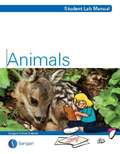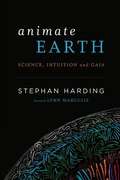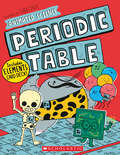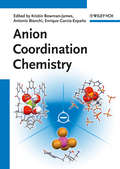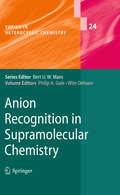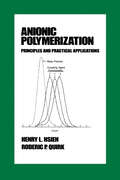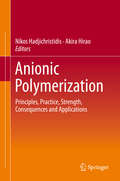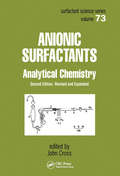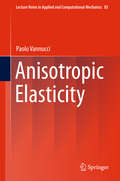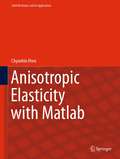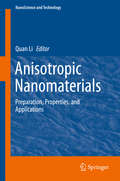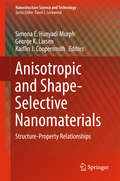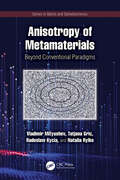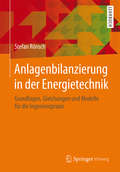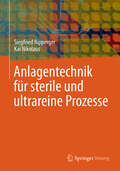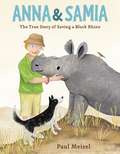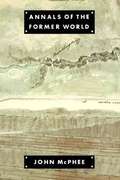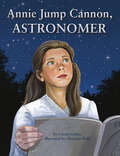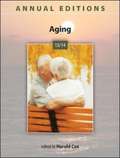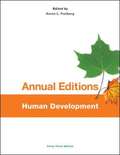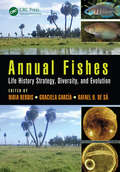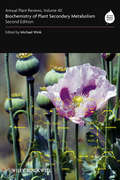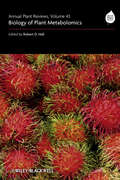- Table View
- List View
Animate Earth
by Lynn Margulis Stephan HardingModern science and western culture both teach that the planet we inhabit is a dead and passive lump of matter, but as Stephan Harding points out, this wasn't always the prevailing sentiment and in Animate Earth he sets out to explain how these older notions of an animate earth can be explained in rational, scientific terms. In this astounding book Harding lays out the facts and theories behind one of the most controversial notions to come out of the hard sciences arguably since Sir Isaac Newton's Principia or the first major publications to come out of the Copenhagen School regarding quantum mechanics. The latter is an important parallel: Whereas quantum mechanics is a science of the problem--it gave rise to the atomic bomb among other things--Gaia Theory in this age of global warming and dangerous climate change is a science of the solution. Its utility: Healing a dying planet becomes an option in a culture otherwise poised to fall into total ecological collapse. Replacing the cold, objectifying language of science with a way of speaking of our planet as a sentient, living being, Harding presents the science of Gaia in everyday English. His scientific passion and rigor shine through his luminous prose as he calls us to experience Gaia as a living presence and bringing to mind such popular science authors as James Gleick. Animate Earth will inspire in readers a profound sense of the interconnectedness of life, and to discover what it means to live harmoniously as part of a sentient creature of planetary proportions. This new understanding may solve the most serious problems that face us as a species today.
Animated Science: Periodic Table
by John FarndonThe elements of the periodic table come alive in the first book in a stellar nonfiction comic series illustrated by Shiho Pate!From oxygen to hydrogen, carbon to plutonium, Animated Science: Periodic Table makes chemistry come alive! In this book you'll meet the building blocks of you, the world, and the universe and see how they come together to make everything you see, do, and use every day.With a narrative nonfiction text, kid-friendly information, and Shiho Pate's engaging illustrations, Animated Science: Periodic Table is a perfect introduction and ready reference, appealing and laugh-out-loud funny. Easily accessible for readers just learning the elements, with more interesting facts and details for older kids honing their knowledge.Great for all ages!
Anion Coordination Chemistry
by Antonio Bianchi Kristin Bowman-James Enrique Garc 237 A-EspanaBuilding on the pioneering work in supramolecular chemistry from the last 20 years or so, this monograph addresses new and recent approaches to anion coordination chemistry. Synthesis of receptors, biological receptors and metallareceptors, the energetics of anion binding, molecular structures of anion complexes, sensing devices are presented and computational studies addressed to aid with the understanding of the different driving forces responsible for anion complexation. The reader is promised an actual picture of the state of the art for this exciting and constantly evolving field of supramolecular anion coordination chemistry. The topics range from ion channels to selective sensors, making it attractive to all researchers and PhD students with an interest in supramolecular chemistry.
Anion Recognition in Supramolecular Chemistry (Topics in Heterocyclic Chemistry #24)
by Philip A. Gale Wim DehaenBrett M. Rambo Eric S. Silver Christopher W. Bielawski Jonathan L. Sessler Covalent Polymers Containing Discrete Heterocyclic Anion Receptors Philip A. Gale Chang-Hee Lee Calix[n]pyrroles as Anion and Ion-Pair Complexants Wim Dehaen Calix[n]phyrins: Synthesis and Anion Recognition Hiromitsu Maeda Acyclic Oligopyrrolic Anion Receptors Jeffery T. Davis Anion Binding and Transport by Prodigiosin and Its Analogs Hemraj Juwarker Jae-min Suk Kyu-Sung Jeong Indoles and Related Heterocycles Pavel Anzenbacher Jr. Pyrrole-Based Anion Sensors, Part I: Colorimetric Sensors Pavel Anzenbacher Jr. Pyrrole-Based Anion Sensors, Part II: Fluorescence, Luminescence, and Electrochemical Sensors Ermitas Alcalde Immaculada Dinarès Neus Mesquida Imidazolium-Based Receptors Nathan L. Kilah Paul D. Beer Pyridine and Pyridinium-Based Anion Receptors Kevin P. McDonald Yuran Hua Amar H. Flood 1,2,3-Triazoles and the Expanding Utility of Charge Neutral CHlllAnion Interactions
Anionic Polymerization: Principles and Practical Applications (Plastics Engineering)
by Henry Hsieh Roderic P. QuirkThis work introduces the basic theories and experimental methods of anionic polymerization as well as the synthesis, analysis and characteristics of anionic polymerized products. It details the creation of linear and branched polymers, random and block copolymers, graft and macromonomers, and many other substances. The work emphasizes the relations
Anionic Polymerization: Principles, Practice, Strength, Consequences and Applications
by Nikos Hadjichristidis Akira HiraoThis book presents these important facts: a) The mechanism of anionic polymerization, a more than 50-year challenge in polymer chemistry, has now become better understood; b) Precise synthesis of many polymers with novel architectures (triblock, multi-block, graft, exact graft, comb, cyclic, many armed stars with multi-components, dendrimer-like hyper-branched, and their structural mixed (co)polymers, etc. ) have been advanced significantly; c) Based on such polymers, new morphological and self-organizing nano-objects and supra molecular assemblies have been created and widely studied and are considered nanodevices in the fields of nano science and technology; d) New high-tech and industrial applications for polymeric materials synthesized by anionic polymerization have been proposed. These remarkable developments have taken place in the last 15 years. Anionic polymerization continues to be the only truly living polymerization system (100 % termination free under appropriate conditions) and consequently the only one with unique capabilities in the synthesis of well-defined (i. e. , precisely controlled molecular weight, nearly mono-disperse molecular weight distribution, structural and compositional homogeneity) complex macromolecular architectures. This book, with contributions from the world's leading specialists, will be useful for all researchers, including students, working in universities, in research organizations, and in industry.
Anionic Surfactants: Analytical Chemistry, Second Edition,
by John Cross"Presents the most comprehensive coverage available of the detection, isolation, identification, and estimation of all anionic surfactants in a wide variety of samples in trace and macro quantities. Features new chapters on volumetric and trace analysis, molecular and mass spectroscopy, and chromatographic processes."
Anisotropic Elasticity (Lecture Notes in Applied and Computational Mechanics #85)
by Paolo VannucciThis book presents a modern and unconventional introduction to anisotropy. The first part presents a general description of Anisotropic Elasticity theories while the second part focuses on the polar formalism: the theoretical bases and results are completely developed along with applications to design problems of laminated anisotropic structures. The book is based on lectures on anisotropy which have been held at Ecole Polytechnique in Paris.
Anisotropic Elasticity with Matlab (Solid Mechanics and Its Applications #267)
by Chyanbin HwuThis book provides the theory of anisotropic elasticity with the computer program for analytical solutions as well as boundary element methods. It covers the elastic analysis of two-dimensional, plate bending, coupled stretching-bending, and three-dimensional deformations, and is extended to the piezoelectric, piezomagnetic, magnetic-electro-elastic, viscoelastic materials, and the ones under thermal environment. The analytical solutions include the solutions for infinite space, half-space, bi-materials, wedges, interface corners, holes, cracks, inclusions, and contact problems. The boundary element solutions include BEMs for two-dimensional anisotropic elastic, piezoelectric, magnetic-electro-elastic, viscoelastic analyses, and their associated dynamic analyses, as well as coupled stretching-bending analysis, contact analysis, and three-dimensional analysis. This book also provides source codes and examples for all the presenting analytical solutions and boundary element methods. The program is named as AEPH (Anisotropic Elastic Plates – Hwu), which contains 204 MATLAB functions.
Anisotropic Metal Chalcogenide Nanomaterials: Synthesis, Assembly, And Applications (SpringerBriefs in Materials)
by Geon Dae MoonThis book explores the recent advances in designing and synthesizing one- and two-dimensional metal chalcogenide nanostructures, along with their practical applications, helping readers understand what has happened, and what is currently happening in the field of nanotechnology. It also includes a comprehensive table showing 1D and 2D nanostructured metal chalcogenides, which presents the recent developments from a synthetic point of view. Further, it describes the wide applicability of anisotropic metal chalcogenides, such as in electronics, energy storage and conversion, and sensors. Lastly it discusses the current understanding of the thermodynamic and kinetic aspects associated with the forming mechanisms of anisotropic metal chalcogenide nanostructures. This book is a valuable reference resource for practitioners and researchers, enabling them to obtain a quick overview of anisotropic metal chalcogenide nanomaterials through synthetic approaches and related applications. Presenting representative applications of anisotropic metal chalcogenide nanomaterials that are important in the industrial sector, it is also of interest to academics and industry specialists.
Anisotropic Nanomaterials: Preparation, Properties, and Applications (NanoScience and Technology)
by Quan LiIn this book anisotropic one-dimensional and two-dimensional nanoscale building blocks and their assembly into fascinating and qualitatively new functional structures embracing both hard and soft components are explained. Contributions from leading experts regarding important aspects like synthesis, assembly, properties and applications of the above materials are compiled into a reference book. The anisotropy, i. e. the direction-dependent physical properties, of materials is fascinating and elegant and has sparked the quest for anisotropic materials with useful properties. With such a curiosity, material scientists have ventured into the realm of nanometer length scale and have explored the anisotropic nanoscale building blocks such as metallic and nonmetallic particles as well as organic molecular aggregates. It turns out that the anisotropic nanoscale building blocks, in addition to direction-dependent properties, exhibit dimension and morphology dependence of physical properties. Moreover, ordered arrays of anisotropic nanoscale building blocks furnish novel properties into the resulting system which would be entirely different from the properties of individual ones. Undoubtedly, these promising properties have qualified them as enabling building blocks of 21st century materials science, nanoscience and nanotechnology. Readers will find this book professionally valuable and intellectually stimulating in the rapidly emerging area of anisotropic nanomaterials. Quan Li, Ph. D. , is Director of the Organic Synthesis and Advanced Materials Laboratory at the Liquid Crystal Institute of Kent State University, where he is also Adjunct Professor in the Chemical Physics Interdisciplinary Program. He has directed research projects funded by US Air Force Research Laboratory (AFRL), US Air Force Office of Scientific Research (AFSOR), US Army Research Office (ARO), US Department of Defense Multidisciplinary University Research Initiative (DoD MURI), US National Science Foundation (NSF), US Department of Energy (DOE), US National Aeronautics and Space Administration (NASA), Ohio Third Frontier, and Samsung Electronics, among others.
Anisotropic and Shape-Selective Nanomaterials: Structure-Property Relationships (Nanostructure Science and Technology)
by Simona E. Hunyadi Murph George K. Larsen Kaitlin J. CoopersmithThis book reviews recent advances in the synthesis, characterization, and physico-chemical properties of anisotropic nanomaterials. It highlights various emerging applications of nanomaterials, including sensing and imaging, (bio)medical applications, environmental protection, plasmonics, catalysis, and energy. It provides an excellent and comprehensive overview of the effect that morphology and nanometric dimension has on the physico-chemical properties of various materials and how this leads to novel applications.
Anisotropy of Metamaterials: Beyond Conventional Paradigms (Series in Optics and Optoelectronics)
by Vladimir Mityushev Natalia Rylko Tatjana Gric Radoslaw KyciaAnisotropy of Metamaterials: Beyond Conventional Paradigms provides a comprehensive introduction to the mathematical modeling of metamaterials based on the macroscopic complex-valued permittivity tensor of dispersed random composites. Key topics include physical and mathematical theory, computer simulations, constructive homogenization, classification of dispersed random composites and their applications in cancer recognition. Image processing and machine learning algorithms are used. The book also discusses the precision of various effective medium approximations, including Bruggeman and Maxwell-Garnett formulas. New analytical, approximate and exact formulas and bounds for the macroscopic permittivity and piezoelectric constants of composites are derived. This book is a valuable tool for academics and professionals in photonics, presenting sustainable materials for sensing, health diagnostics and cancer detection methodologies.Key features: Offers key insights into the current trends and techniques in the study of the macroscopic properties of metamaterials, aiming at stimulating new avenues of research Presents examples of image analysis, the primary tool for non-destructive metamaterials analysis Discusses the applications of Machine Learning to image processing, illustrated using specific code in Python programming language
Ankho Ki Chamak
by Arvind GuptaArvind Gupta, the author, is the winner of the National Award for Science Popularisation amongst children (1988) and the distinguished alumnus award from IIT Kanpur.(2000). Arvind has dedicated his life to teaching science to underprivileged children in rural ares by employing simple stories and toys. Here is one such treasure.
Anlagenbilanzierung in der Energietechnik: Grundlagen, Gleichungen und Modelle für die Ingenieurpraxis
by Stefan RönschDieses Lehrbuch beschreibt ausführlich das Vorgehen und die Methodik von Anlagenbilanzierungen in der Energietechnik. Studenten und Ingenieuren wird damit ein umfangreiches Rüstzeug zur Planung und Optimierung der Anlagen an die Hand gegeben. Neben Grundgleichungen, Modellierungsansätzen und numerischen Methoden wird die stoffliche und energetische Bilanzierung anhand einer Vielzahl von Beispielrechnungen ausgeführt. Das Buch spannt dabei einen Bogen von der Funktionsweise der Komponenten über die Grundlagen der Thermodynamik, Reaktionsrechnung, Phasengleichgewichtsrechnung und Stoffwertberechnung bis hin zur computergestützten Umsetzung. Beachtung finden alle relevanten Anlagenkomponenten der Energietechnik wie Brennkammern, Turbinen, Kompressoren, Wärmetauscher, Gleichgewichtsstufen und Synthesereaktoren.
Anlagentechnik für sterile und ultrareine Prozesse
by Siegfried Ripperger Kai NikolausDieses Fachbuch beschreibt die Grundlagen zur Gestaltung von Apparaten für die sterile Prozesstechnik unter Beachtung der aktuellen Regeln und Vorschriften. Unter dem Begriff sterile Prozesstechnik werden die spezifischen Randbedingungen der Apparate- und Anlagentechnik für die Lebensmittel-, Pharma- und Bioverfahrenstechnik zusammengefasst. Diese ergeben sich aus dem möglichen Verderb der zu verarbeitenden Produkte und den dadurch zu beachtenden hygienischen Anforderungen. Die Anforderungen, die sich aus der Reinigung und Desinfektion bzw. Sterilisation der Anlagen ergeben sowie die zugehörigen Regeln zum „Hygienic Design“ der Anlagen werden ausführlich behandelt. Beschrieben werden außerdem die hierbei zu beachtenden speziellen regulatorischen Aspekte und die erarbeiteten technischen Regeln, die über die des üblichen Anlagenbaus hinausgehen. Zunehmend kommen Single-Use-Elemente im Zusammenhang mit der sterilen Prozesstechnik zur Anwendung, daher wurde diesem Trend ein eigenes Kapitel gewidmet.
Anna & Samia: The True Story of Saving a Black Rhino
by Paul MeiselFrom Geisel Honor–winning author/illustrator Paul Meisel comes Anna & Samia, the true story of a wildlife conservationist and the baby rhinoceros she adopts.When infant rhino Samia finds herself all alone in the vast Kenyan rhino sanctuary, conservationist Anna Merz knows just what to do. Little by little, she helps Samia feel warm and at home, snuggling with the black rhino in her bed, deciphering every snort and eek, and giving Samia baths to keep her clean. Each step Anna takes is meant to help Samia get closer to becoming independent. But the bond between Samia and Anna is so strong that Samia may not want to leave, even when she's ready. Can Samia learn to explore the sanctuary on her own? Here is a heartfelt true story about love, growing up, and letting go.
Annals of the Former World
by John McpheeJohn McPhee describes a cross-section of North America and comes to an understanding not only of the science but of the style of the geologists he traveled with. Completed in four stages under the collected title: Annals of the Former World. <P><P> Winner of the Pulitzer Prize.
Annie Jump Cannon, Astronomer
by Carole Gerber"Parents and teachers ask me for the names of books for their primary school children. I'm honored to recommend Annie Jump Cannon, Astronomer by Carole Gerber, an excellent book about a true astronomical pioneer." -Paul Kohlmiller, editor, San Jose Astronomical Association newsletter This brilliantly illustrated children's book depicts the achievements of a woman who developed an important system of classifying stars. To this day, Annie Jump Cannon holds the record for identifying more stars than anyone else in the world. In 1925, she became a professor of astronomy at Harvard and the first woman to receive a doctor of science degree from Oxford University. Born during the Civil War, Cannon was determined to pursue a career in astronomy. From her childhood days of studying the constellations with her mother, to her education at Wellesley College and her job in the Harvard Observatory, this biography follows Cannon's inspirational path to success. The story notes the challenges the astronomer faced, such as an illness that left her partially deaf and gender discrimination, while capturing her shining moments as she worked to become the "census-taker of the stars."
Annual Editions: Aging 13/14 (26th Edition)
by Harold CoxThis is a series that publishes compilation of recent articles from over 300 sources including respected newspapers, magazines and journals, and makes them valuable resources for classroom use with relevant exercises.
Annual Editions: Human Development, 43/e
by Karen FreibergThe Annual Editions series is designed to provide convenient, inexpensive access to a wide range of current articles from some of the most respected magazines, newspapers, and journals published today. Annual Editions are updated on a regular basis through a continuous monitoring of over 300 periodical sources. The articles selected are authored by prominent scholars, researchers, and commentators writing for a general audience. Each Annual Editions volume has a number of features designed to make them especially valuable for classroom use: an annotated Table of Contents, a Topic Guide, an annotated listing of supporting websites, Learning Outcomes and a brief overview for each unit, and Critical Thinking questions at the end of each article. Go to the McGraw-Hill CreateTM Annual Editions Article Collection at www. mcgrawhillcreate. com/annualeditions to browse the entire collection. Select individual Annual Editions articles to enhance your course, or access and select the entire Freiberg: Annual Editions: Human Development, 43/e ExpressBook for an easy, pre-built teaching resource by clicking here. An online Instructor's Resource Guide with testing material is available for each Annual Editions volume. Using Annual Editions in the Classroom is also an excellent instructor resource. Visit the Create Central Online Learning Center at www. mhhe. com/createcentral for more details.
Annual Fishes: Life History Strategy, Diversity, and Evolution
by Ronald EislerAnnual Fishes: Life History Strategy, Diversity, and Evolution is the first comprehensive reference on current knowledge of diverse species that exhibit unique survival strategies and provide important models for basic and applied research. This work fills a void, covering the life cycle, reproductive biology, evolutionary ecology, reproductive beh
Annual Plant Reviews, Biochemistry of Plant Secondary Metabolism (Annual Plant Reviews #62)
by Michael WinkThis brand new Annual Plant Reviews volume is the second edition of the highly successful and well-received Annual Plant Reviews, Volume 2. This exciting new volume provides an up-to-date survey of the biochemistry and physiology of plant secondary metabolism. The volume commences with an overview of the biochemistry, physiology and function of secondary metabolism, followed by detailed reviews of the major groups of secondary metabolites: alkaloids and betalains, cyanogenic glucosides, glucosinolates and nonprotein amino acids, phenyl propanoids and related phenolics, terpenoids, cardiac glycosides and saponins. A final chapter discusses the evolution of secondary metabolism. This carefully compiled new edition brings together chapters from some of the world's leading experts in plant secondary metabolism. Completely revised and brought right up to date with much new information, this volume is an essential purchase for advanced students, researchers and professionals in biochemistry, physiology, molecular biology, genetics, plant sciences, agriculture, medicine, pharmacology and pharmacy, working in the academic and industrial sectors, including those working in the pesticide and pharmaceutical industries. Libraries in all universities and research establishments where these subjects are studied and taught will need copies of this excellent volume on their shelves. A companion volume Annual Plant Reviews Volume 39, Functions and Biotechnology of Plant Secondary Metabolites, Second Edition, Edited by M. Wink, is also available.
Annual Plant Reviews, Biology of Plant Metabolomics (Annual Plant Reviews #59)
by Robert D. HallBiology of Plant Metabolomics is an exciting new volume in Wiley-Blackwell's highly successful Annual Plant Reviews series. Concentrating on the biology and biological relevance of plant metabolomics, each chapter, written by internationally-acknowledged experts in the field from at least two different research groups, combines a review of the existing biological results with an extended assessment of possible future developments and the impact that these will have on the type of research needed for the future. Following a general introduction, this exciting volume includes details of metabolomics of model species including Arabidopsis and tomato. Further chapters provide in-depth coverage of abiotic stress, data integration, systems biology, genetics, genomics, chemometrics and biostatisitcs. Applications of plant metabolomics in food science, plant ecology and physiology are also comprehensively covered. Biology of Plant Metabolomics provides cutting edge reviews of many major aspects of this new and exciting subject. It is an essential purchase for plant scientists, plant geneticists and physiologists. All libraries in universities and research establishments where biological sciences are studied and taught should have a copy of this Annual Plant Reviews volume on their shelves.
